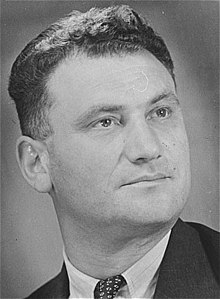Tuvia Bielski
Tuvia Bielski | |
|---|---|
 Bielski c. 1950–1955 | |
| Born | May 8, 1906 |
| Died | June 12, 1987 (aged 81) New York City, U.S. |
| Nationality | Belarusian |
| Known for | Bielski partisans |
| Spouse |
Lila Tiktin (m. 1943) |
| Children | 3 |
| Parent(s) | David and Beila Bielski |
| Relatives | Asael Bielski, brother Alexander Zeisal Bielski, brother Aron Bielski, brother |
Tuvia Bielski (May 8, 1906 – June 12, 1987) was a Belarusian Jewish militant who was leader of the
Biography
Bielski grew up in the only Jewish family in Stankiewicze. The small village in
Tuvia was the son of David and Beila Bielski, who had 12 children: 10 boys and two girls. Tuvia was the third eldest. His brothers Asael, Alexander ("Zus") and Aron were later to become members of his partisan group.
In 1927, Bielski was recruited into the
During the
In Soviet-controlled Lida, Bielski met and fell in love with another woman named Sonia Warshavsky. The love affair became serious. In late 1939, Bielski divorced his wife, Rifka[2] and married Sonia, though they were not yet "officially" married due to wartime conditions.[3] Sonia was killed while taking shelter with others in a peasant home. Not long after, Tuvia married Lila "Lilka" Tiktin, who was only 17 at the time. They knew each other before the war and stayed married until his death 44 years later.[4]
World War II
When
Tuvia Bielski led a group of
In 1944, Asael Bielski was conscripted into the Soviet Army and killed in battle in Germany.[3]
Later life
After the war, Tuvia, Zus and their wives went to Israel via Romania, and ultimately immigrated to the United States in 1956. They joined their older brother Walter in New York, where he had gone before the war.[3] Tuvia and Zus ran a small trucking firm in New York City for 30 years. He remained married to Lilka for the remainder of their lives. They had three children: sons Michael and Robert, and daughter Ruth, and ten grandchildren. Granddaughter Sharon Rennert made a documentary about her family called In Our Hands: The Legacy of the Bielski Partisans.[7]
When Tuvia died in 1987, he was nearly penniless. He was initially buried on Long Island; one year after his death, his remains were exhumed and taken to Jerusalem, where he was given a state funeral with full military honors in 1988. The exact grave is at Har Tamir, a part of Har HaMenuchot. The following location is in Hebrew using Latin letters: Gush taf-bet, Chelka daled, Shura 19, kever 11 (block 402, section 4, row 19, grave 11).[3]
Legacy
References
- ^ ISBN 0-19-509390-9.
- ISBN 0-19-509390-9.
- ^ a b c d e f Duffy, Peter (May 28, 2000). "Heroes Among Us". The New York Times. Retrieved May 6, 2015.
- ^ Defiance: the Bielski partisans. Nechama Tec. Oxford University Press. 1993
- ISBN 0-19-509390-9.
- ISBN 9780099551799.
- ^ Children of the Otriad, (c) 2008 Paramount Pictures Corporation, included with special features on the 2008 DVD Defiance
- ^ "Bohater w cieniu zbrodni". Rzeczpospolita. Archived from the original on 2012-10-04. Retrieved 2011-01-20.
- ^ "Bielski w puszczy niedomówień". Rzeczpospolita. Archived from the original on 2011-07-18. Retrieved 2011-01-20.
- ^ "Instytut Pamięci Narodowej | Komunikat dot. śledztwa w sprawie zbrodni popełnionych przez". Ipn.gov.pl. 2008-06-19. Retrieved 2018-02-07.
